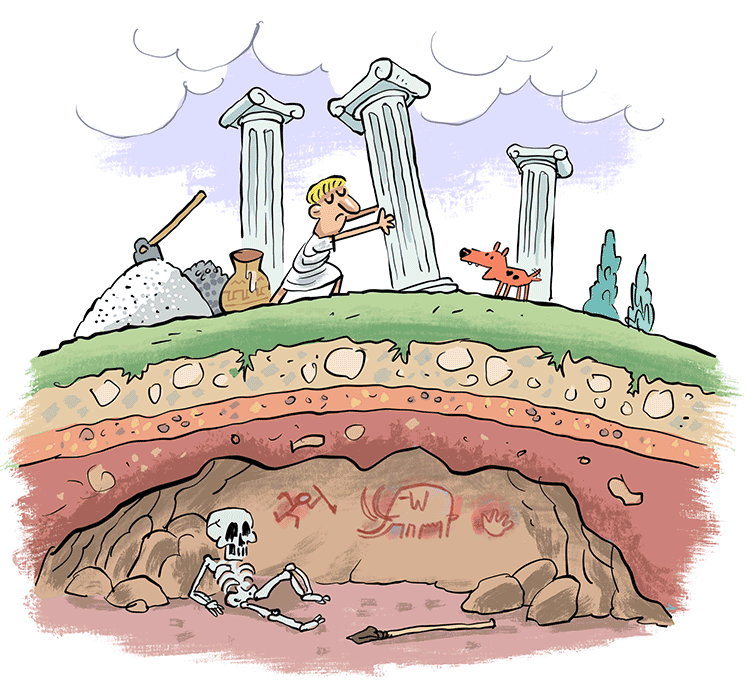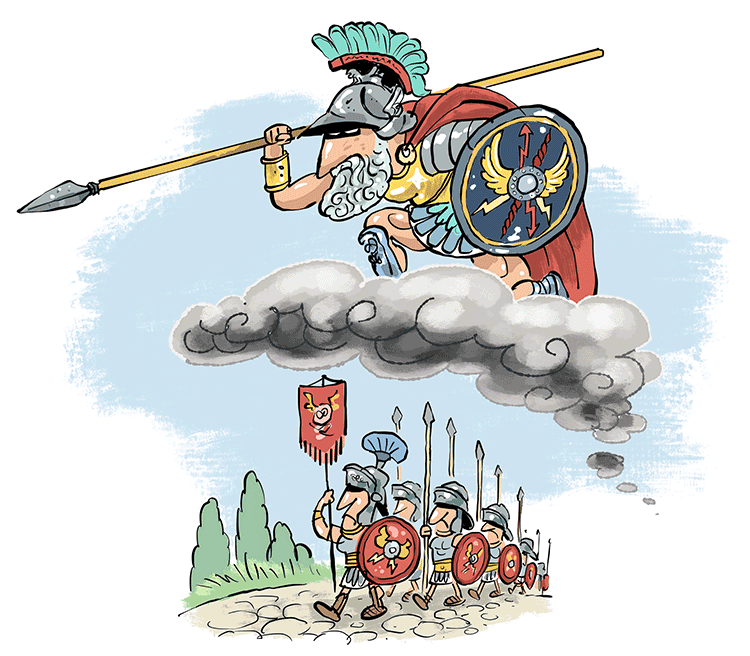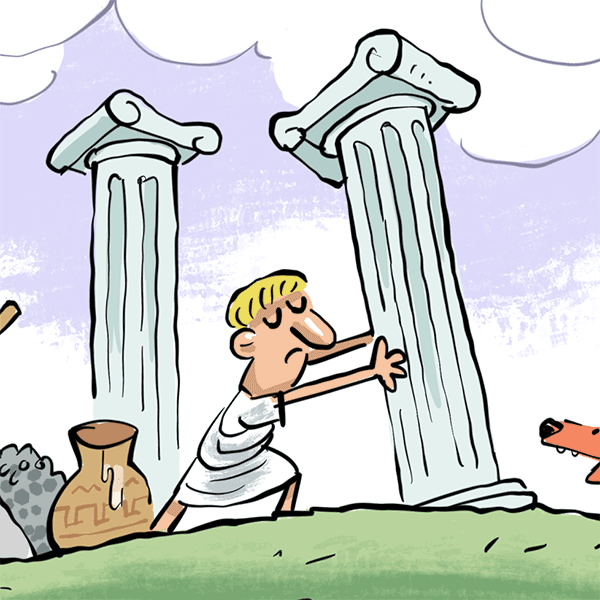Today, people refer to the United States as a “City Upon a Hill.” Derived from the Bible, this phrase was first used in reference to the initial English settlements in what is now Massachusetts. Their hope was to found a city so wonderful it would set the “standard” and be the model for other cities.
Since colonial times, many people in the US, particularly politicians, have come to refer to the entire nation as the “city upon a hill,” suggesting it is the leader of today’s modern world.
Whether or not you see the modern US as a standard to pursue or a true leader doesn’t take away from the influence America has on today’s modern world.
However, long before the United States existed, there was a “city upon seven hills.”
That city was Rome.
Placed upon seven hills of now-international fame, Rome was the city of the ancient world. Throughout the 1st millennia BC, Rome went from a small town to the capital city of the world’s largest empire. Its influence stretched from what is now Spain and England to Afghanistan and beyond.
Over time, the story of how Rome initially emerged from next to nothing to rule the ancient world became one of legend. But tracing it, and finding the truth in it, is essential to understanding how our world became what it is today.
This is that story.
The Founding of Rome
Unlike other ancient cities, Rome has a birthday: April 21, 753 BC. It was, apparently, on that exact day when Romulus, the man for which the city would be named, settled upon Palatine Hill, which was to become the center of Rome.
We know this, of course, because Romulus, soon after erecting his makeshift house, wrote down the date to mark the occurrence.
Actually, no. The early Romans couldn’t write.
So, how do we know this date? Well, we know it because a man named Marcus Terentius Varro, in the first century BC (so six hundred years later), said it was officially so.

Separating Myth and Truth
The reality is that we don’t know exactly when Rome was officially founded. These dates, and many of the stories surrounding the founding of Rome, emerged later on in Roman history when having a unifying story became important for consolidating the power of a growing empire.
Archaeological evidence does seem to suggest that the population in the area that became Rome grew during the eighth century BC, aligning nicely with the “official” date.
However, there is plenty of evidence that people had been living there for centuries prior to what we now call Rome’s birthday. In fact, people may have been living in the area for more than 14,000 years, making the Romans latecomers to the party.
While a true consensus still eludes historians, most do agree that the Rome that would emerge to dominate the ancient world appeared as a true city and not just a settlement in the eight century BC.
A Latin City
One leading theory of the founding of Rome is that the Latins, the tribe that went on to found Rome, fled south from what is now Northern Italy from the Etruscans, the dominant tribe on the peninsula at the time. Both of these tribes, along with the Sabines, were “Italic,” a word used to describe their similar language.
However, despite being the dominant cultural group on the Italian peninsula (the name comes from Italic), and despite being somewhat similar, they fought frequently and saw each other as enemies.
For this reason, the Latins may have founded the city that later became Rome, perhaps with the Sabines, purely out of self-defense.
Of course, we may never know the exact story behind the moment Rome became a city. No one at the time knew how to write, so we can only guess from archaeological evidence.
To some extent, though, the real story doesn’t matter. What’s more important is what people believed, and that story has gone down as one of the most well-known from the ancient world.

The Story of Romulus and Remus
The traditional legend of the founding of Rome involves two brothers: Romulus and Remus. They were born to the daughter of an ancient Roman king, Numitor, and Mars, the Roman god of war.
Eventually, Numitor was removed as king by his brother, Amuluis, and when this happens, he orders the two brothers to be abandoned by the river to die. It seems he didn’t want to give them even the chance to challenge him.
Left to die, Romulus and Remus were saved by a she-wolf, a mythical creature that is part wolf-part woman, and she nursed them and raised them until they were adults.
Once grown, the two brothers joined forces to kill Amuluis and give the throne back to their grandfather. They succeeded and then decided to leave and found a new city of their own.
Romulus decided to settle on the Palatine Hill and Remus went to the Aventine Hill, two of the seven hills that would later make up Rome. This dispute, about which hill to make the center of their new city, escalated — quickly — and Romulus ended up killing his brother.
Palatine Hill it is, then! He said, his hands stained with the blood of his own kin. And Rome was founded.
The Aeneid By Virgil
This story has been taken to be the original founding myth of ancient Rome. But it actually didn’t appear in Roman texts until the fourth century BC.
Eventually, though, as Roman influence grew and it became more and more an empire, there was a need to make this story more accessible to all.
Enter the poet Virgil.
Borrowing characters from the ancient Greek poet Homer’s epic the Iliad, Virgil wrote the Aeneid some time between 29 BC and 19 BC, during the first decade of the Roman Empire. His motivation was partly to write an interesting and exciting piece of literature, but it was also an attempt to connect the traditional myth of Rome’s founding with important stories from other cultures, mainly Greek, in an effort to solidify the power of Rome.
If you’re a bit rusty on Classic literature, this epic poem told the story of Aeneas, who fought for Troy in the Trojan Wars, an ancient conflict between Sparta and Troy.
In the poem, after Troy’s defeat, Aeneas rallied the survivors and led them to Italy. There, they mingled with the locals, and founded their own city. Aeneas’ son, Ascanius, established a city known as Alba Longa.
The dynasty that ruled there also produced names such as Numitor, Amuluis, Romulus, and Remus. Sound familiar?
Greece, Fratricide, and War
The actual truth of these stories is somewhat irrelevant. It’s what people believed at the time, and this had a tremendous influence on Roman culture.
One way it did this was by connecting Rome to Greece. In the early days of Roman history, the Greeks were the cool kids of the ancient world. Their cities — Athens, Sparta, Corinth, Thebes, to name a few — were the wealthiest and most powerful in all of the ancient world.
Eventually, under Alexander the Great, the Greeks established an empire that stretched from Greece all the way to India, including Egypt and the Middle East.
So, when the Romans conquered Greece in the last century BC, they took control of a rather large Greek world. Controlling it would have required winning the will of the people, which they did by mixing their myths.
Many Roman gods became associated with Greek ones, and stories such as the Aeneid were told to trace Roman lineage back to the Greeks. In fact, Julius Caesar, unofficially Rome’s first emperor, claimed to be the ancestor of Aeneas, a move he made to legitimize his rule, particularly with his many new Greek subjects.
Sibling Conflicts
Another important element of Rome’s origin story is that the founding of Rome came about as a result of fratricide, a word used when one brother kills another.
Throughout Rome’s history, even in its most prosperous years, its politics were plagued with infighting and conflict. Many Roman politicians were assassinated when they were disliked by rival factions, the most famous being Julius Caesar himself.

The God of War
The other important influence is the role of the god Mars. As the patron of war, and the potential father of Rome, his presence in the founding story speaks to how Rome saw war: as a fact of life, and as essential to their identity.
This lines up with Roman history, which is nearly entirely defined by war.
Again, these founding stories emerged much after the actual founding of Rome, and so they can be seen more as a reflection of how Romans saw themselves at the time.
Now, when we look back and study Rome, we can see that their image of themselves was pretty much spot on.
The Roman Kingdom
Whether or not Romulus was the son of Mars will always be up for debate, but we do know that the first recorded king of Rome was indeed named Romulus.
He started a dynasty that became known as the Alban dynasty and which lasted roughly 250 years, from 753 BC to 509 BC. In total, seven kings, whose names we know thanks to stone inscriptions, ruled Rome in its days as a monarchy.
However, beyond their names, little is known about these men. The Romans in those days didn’t know how to write. It’s believed that some of these kings may have actually been Etruscans, not Latins, meaning the tribe they originally tried to flee may have regained control for some time. But even this remains speculation.
One thing we do know is that Roman kings were elected. This tradition of letting the people, or at least some people, choose the leader of Rome existed for almost its entire history, especially during its time as a republic.
Also, Romulus is credited with having founded the Senate. Yes, early Rome was a monarchy, ruled by a king, but the Senate gave the wealthy, aristocratic classes a voice in the affairs of the state. The Senate remained relevant for nearly 1,000 years after it was established.
The Birth of the Roman Republic
Over time, the Senate became more and more powerful, and then in 509 BC, the king was removed, turning Rome into a republic.
By this point, Rome was becoming much more than a city. It had begun expanding in the Italian peninsula and would soon start clashing with international powers.
Because Rome grew so much during its time as a republic, the moment it emerged is often seen as a starting point for Roman history. A point in time after which history would never be the same.
Written by Matthew Jones
Illustrated by Jean Galvao
